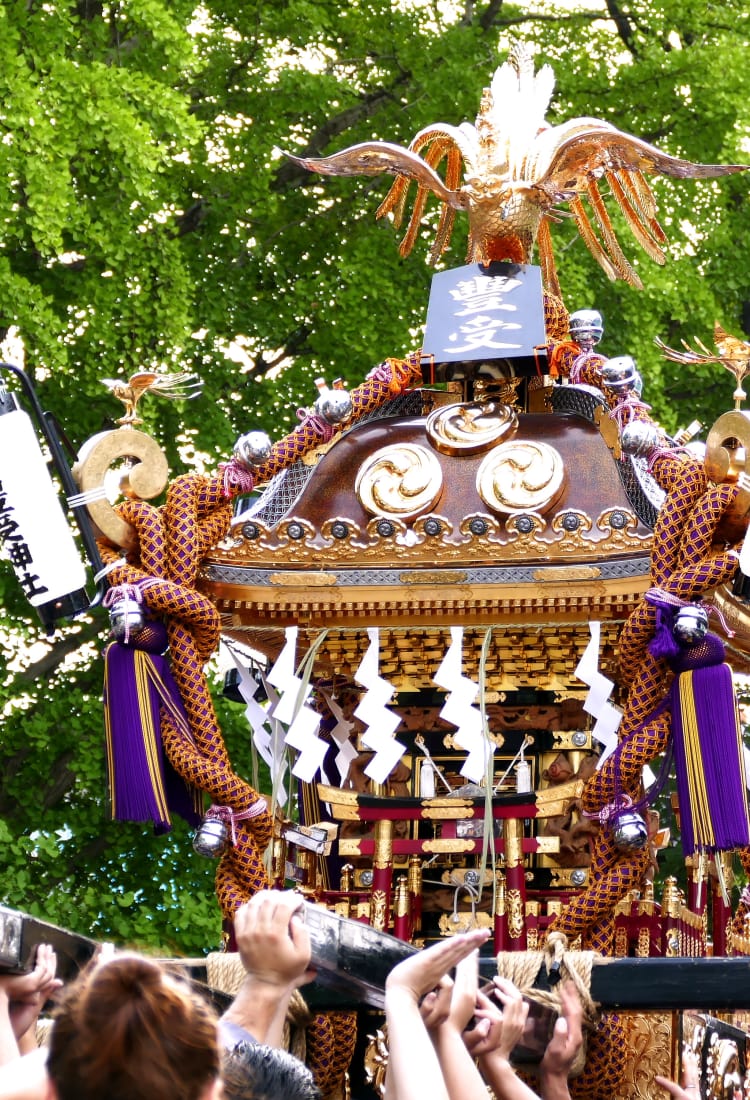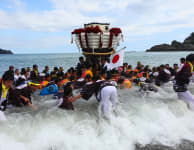Matsuri are one of the most important aspects of Japanese culture
What is a matsuri?
Matsuri are Japanese festivals and are a way for the local community to get together and celebrate. Nearly all matsuri have some connection to Buddhism, Shinto, the four seasons or important historical events, though a few of them rely entirely on the beauty of fireworks. Matsuri can sometimes feature dignified religious processions that accompany a Shinto god from one shrine to another. Other times they are casual secular gatherings related to the seasons. For instance, when spring turns the landscape into a fleecy patchwork of cherry blossoms, people flock to parks to gaze at the pink blooms and enjoy a festive atmosphere. Certain matsuri are observed nationwide, but most are neighborhood affairs that have sprung up from the many microcultures of Japan, resulting in a multitude of unusual local festivals that are still celebrated today.

Joining a matsuri is a fun way to learn more about local culture
Common elements of a matsuri
Mikoshi
Many matsuri feature a mikoshi, a sacred palanquin. It's effectively a mini portable shrine. Shrine-goers pick up the deity from their home shrine and parade it around the neighborhood. At some festivals, the procession is steady and fluid. At others, the mikoshi is rocked back and forth for the deity's amusement.
Dashi Floats
Dashi are floats that represent local spirits and gods in the parade. They are pulled, rather than carried like mikoshi, and are extravagantly decorated. They can be small, pulled by just four or five people, or as large as buildings.
Music
Matsuri music is full of traditional sounds made by haunting reed flutes called hichiriki, plucky shamisen, and pounding taiko drums. Joining the instruments are the kakegoe, the various cries and shouts let loose by performers and spectators alike.
Dress
Matsuri participants wear various styles of dress, including hachimaki (stylized headbands), happi (coats that bear community symbols) and tabi (a type of cloth footwear with a split between the big toe and the rest of the toes to accommodate geta, traditional wooden sandals). Yukata, summer kimono, are also common sights that many spectators choose to wear.
Food Stalls
Yatai, or food stalls, sell both traditional and innovative matsuri foods. Popular foods are yakitori, which are grilled skewered meats, takoyaki, battered octopus bites shaped into a ball, and hashimaki, a savory crepe rolled around a pair of chopsticks for easy eating. Many people take food home as a souvenir for those who can't attend the festival.


Dress the part
How can I participate?
Traditionally, matsuri are festivals put on for the community in honor of local deities or historical moments. Since many of them are celebrated for reasons that only pertain to the region in which they're held, they aren't necessarily open to tourist participation. But even if you can't join a carefully planned religious procession, there are other things you might be able to do. Some matsuri are opening up to the wider public to include visitors from abroad.
At some festivals, spectators might even be offered the chance to carry a mikoshi. Obon, an extremely important Buddhist festival in the summer, is celebrated all over Japan, and bon odori dancing during that time is open to everybody. Basic dances are easy to learn and the locals will be delighted to share their moves with you. If dancing or being in the public eye makes you uncomfortable, you can always choose to quietly participate by dressing up in a yukata, munching on festival foods, and soaking up the atmosphere from the sidelines.

A matsuri is a fun experience for all the family
Get involved—matsuri you can join
There are matsuri allowing active participation all over Japan. The Awa Odori in Tokushima City is one of the largest dance festivals in Japan with 1.4 million attendants, and certain areas allow anybody to join the routine. In Okinawa, the Naha Ohtsunahiki Festival, which is said to have started around 1450, is a giant, 15,000-person tug-of-war. Simply pick a side and pull with all your strength. If you're a sake enthusiast, Kitsuki City in Oita holds a yearly Doburoku festival in October. Doburoku is a boozy, unfiltered proto-sake drink. Pay your respects at the shrine, indulge in as many cups as your sake-loving heart desires, then consider entering the beard and hair competition with your newfound confidence.
There are also matsuri that are charmingly strange. In Higashi-Osaka City, the Owarai Festival involves some 3,000 people laughing continuously for 20 minutes to ensure happiness for the community. As laughter knows no language barrier, it's easy to participate. Or there is the Muon Bon Odori in Tokai City, Aichi, which is a totally silent dance festival. Created in response to noise complaints, festival music is streamed into the dancers' headphones, leading to a bizarrely silent spectacle to those who aren't in on it. Join in by popping in your headphones and moving.

Efforts are being made to protect the very rare marimo
Matsuri are not always about fun and games; some of them focus on more serious issues. The Marimo Matsuri takes place in Kushiro City in Hokkaido and is centered around conservation efforts to protect the marimo—very rare, spherical algae balls that grow in the waters of Lake Akan. The Ainu, the indigenous Japanese people, perform a number of rituals. Watch from the lakeshore as traditionally-dressed Ainu row out into the lake or join many others on the streets to see the torch-lit procession.
Matsuri do's and don'ts
To keep the integrity of the matsuri, be respectful of Japanese culture and traditions. Here are some do's and don'ts to keep in mind.
Don't cut lines or litter. Waiting is annoying, and garbage is cumbersome, but please respect the local rules. Don't expect the community to serve you. You're a tourist participating in Japanese culture. Not everything will happen as it does in your home country. Keep an open mind. Don't interrupt choreographed events. Be aware of your surroundings. Don't be shy. Feel free to ask questions if you feel lost.
Do engage with locals and participate when you can, by dressing up and learning local dances. Do be adventurous with the delicious foods. Do have fun and make friends.





























































